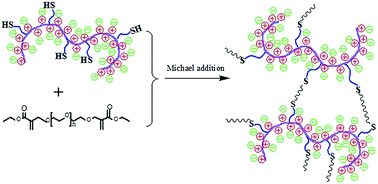An in situ-forming zwitterionic hydrogel as vitreous substitute†
Abstract
Zwitterionic polymers have shown ultra-low biofouling properties at surfaces and excellent biocompatibility as implant. In this study, an in situ-forming zwitterionic hydrogel was designed and evaluated, both in vitro and in vivo, as a long-term vitreous substitute. The zwitterionic polymer poly(MPDSA-co-AC) was designed as a copolymer of the sulfobetaine methacrylamide and acryloyl cystamine monomers, providing the zwitterionic components and the thiol functional groups, respectively. The in situ gelation was via the thiol–ene Michael addition reaction with α-PEG-MA as the crosslinker. The gelation time, rheological properties, swelling profiles, and the transparency of zwitterionic hydrogels were studied in detail. Two systems with different crosslinker concentrations were tested in a rabbit model, and the one with the thiol–ene ratio of 2 : 1 showed excellent biocompatibility in vivo, formed space-filling hydrogels and remained transparent in the vitreous cavity for the 2 month implantation period. Therefore, in situ-forming zwitterionic hydrogels represent a promising material system as a vitreous substitute and possibly for other soft tissue replacements.


 Please wait while we load your content...
Please wait while we load your content...